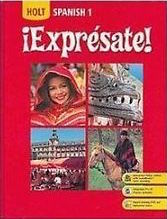
Expresate!: Spanish 1
1st Edition
ISBN: 9780030452048
Textbook solutions
All Solutions
Page 61: 25
Exercise 1
Step 1
1 of 4
This question asks you to form sentences using one word from each column, making sure the articles and adjectives match in gender and number. Our first article is *el*.
Step 2
2 of 4
On page 60 we learned that *el* is a singular, masculine article. This means that the noun it is attached to must also be singular and masculine. Looking at list 2, we can’t choose any noun that ends in “-a” (indicating a feminine noun) or any noun that ends in “-s” (indicating a plural noun). Our only two options are *español* or *helado*.
Step 3
3 of 4
Regardless of which of the two nouns you chose, the only option in box 3 is *es* since we’re dealing with a singular subject.
Step 4
4 of 4
Finally, choose an adjective from box 4. It doesn’t matter which one you choose so long as it is written in masculine, singular form to match the article from box 1.
Exercise 2
Step 1
1 of 4
This question asks you to form sentences using one word from each column, making sure the articles and adjectives match in gender and number. The example reads, “Mexican music is awesome”.
Our second article is *la*.
Our second article is *la*.
Step 2
2 of 4
We learned on page 60 that *la* is the feminine, singular article. This means we need a noun from column 2 that is also in a feminine, singular form. We can narrow down our choices by avoiding any nouns that end in “-s” (indicating a plural form) or “-o” (indicating a masculine word). This leaves us solely with *música mexicana”.
Step 3
3 of 4
We established that our article is singular. This means that we will be using the singular form of *ser* as well, which is *es*.
Step 4
4 of 4
Finally, choose an adjective. It doesn’t matter which one, just so long as it is written in its feminine, singular form.
For example, if you chose *serio*, you would need to change it to *seria*, as *serio* is the masculine, singular form of the word, and we need the feminine, singular form.
For example, if you chose *serio*, you would need to change it to *seria*, as *serio* is the masculine, singular form of the word, and we need the feminine, singular form.
Exercise 3
Step 1
1 of 5
This question asks you to form sentences using one word from each column, making sure the articles and adjectives match in gender and number. Our third article is *los*.
Step 2
2 of 5
You’ll see from the chart on page 60 that *los* is simply the plural form of *el*, meaning it’s still masculine. This means our noun from column two must be in the plural, masculine form as well.
Step 3
3 of 5
We have three nouns that are plural (*estudiantes, deportes* and*fiestas*). We know *fiestas* is feminine because it ends in “a”, so we can’t use that one. *Estudiantes* can take either form depending on the gender breakdown of the group. *Helado* ends in “-o”, therefor it is masculine. If you choose *helado*, make sure to add an “s” for the plural form.
Step 4
4 of 5
Since our article is plural, we need to use the plural form of *ser* from column three, which is *son*.
Step 5
5 of 5
Finally, our adjective in column four must be in its masculine, plural form. Choose an adjective that makes sense logically given your noun (meaning, don’t choose *delicioso* if your noun is *los estudiantes*!). If you, for example, choose *gracioso*, you must make sure you use the plural form *graciosos*. It is already written in its masculine form.
Exercise 4
Step 1
1 of 4
This question asks you to form sentences using one word from each column, making sure the articles and adjectives match in gender and number. Our fourth and final article is *las*.
Step 2
2 of 4
We learned that *las* is the plural form of *la*, making it feminine. You must choose a feminine noun from column two, and make it plural to match the article. The word *fiestas* is the only word in the column that is actually already written in the correct form.
Step 3
3 of 4
In column three, we again have to make sure to use the plural *son* to connect our noun to our adjective. Don’t be confused by the addition of *somos* in column three: This is the *nosotros* form of *ser* and is not used in this exercise at all.
Step 4
4 of 4
Finally, we must choose an adjective that not only makes logical sense given our noun from box two, but is also in the feminine, plural form, to match our article. Remember, feminine words end in “-a” and the addition of an “s” after that makes it plural. Therefore, a word like *bueno* would become *malas*.
unlock

